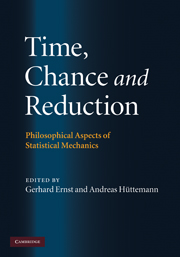Book contents
6 - Probability in Boltzmannian statistical mechanics
from Part II - Probability and chance
Published online by Cambridge University Press: 04 August 2010
Summary
Introduction
A cup of tea, left to its own, cools down while the surrounding air heats up until both have reached the same temperature, and a gas, confined to the left half of a room, uniformly spreads over the entire available space as soon as the confining wall is removed. Thermodynamics (TD) characterizes such processes in terms of an increase of thermodynamic entropy, which attains its maximum value at equilibrium, and the second law of thermodynamics posits that in an isolated system entropy cannot decrease. The aim of statistical mechanics (SM) is to explain the behaviour of these systems, in particular their conformity with the second law, in terms of the dynamical laws governing the individual molecules of which the systems are made up. In what follows these laws are assumed to be the ones of classical mechanics.
An influential suggestion of how this could be achieved was made by Ludwig Boltzmann (1877), and variants of it are currently regarded by many as the most promising option among the plethora of approaches to SM. Although these variants share a commitment to Boltzmann's basic ideas, they differ widely in how these ideas are implemented and used. These differences become most tangible when we look at how the different approaches deal with probabilities. There are two fundamentally different ways of introducing probabilities into SM, and even within these two groups there are important disparities as regards both technical and interpretational issues.
- Type
- Chapter
- Information
- Time, Chance, and ReductionPhilosophical Aspects of Statistical Mechanics, pp. 92 - 118Publisher: Cambridge University PressPrint publication year: 2010
References
- 10
- Cited by



